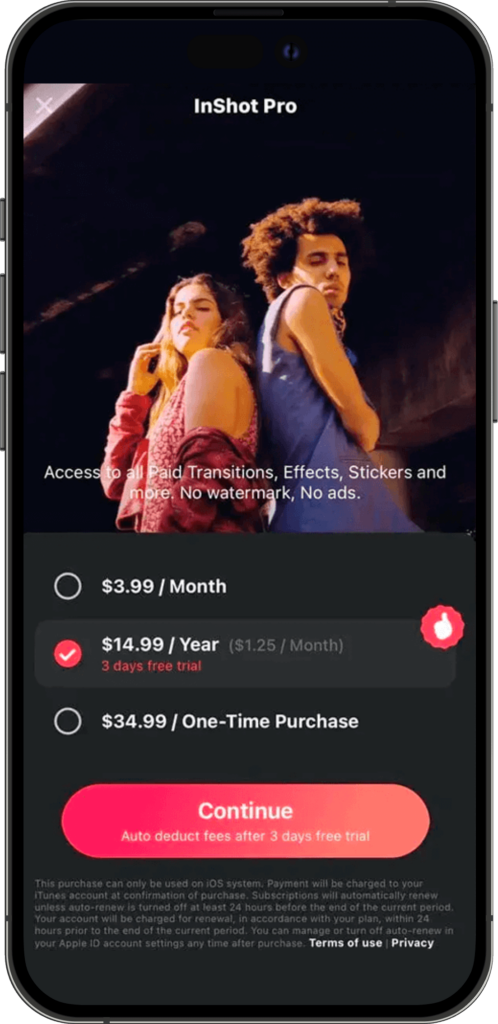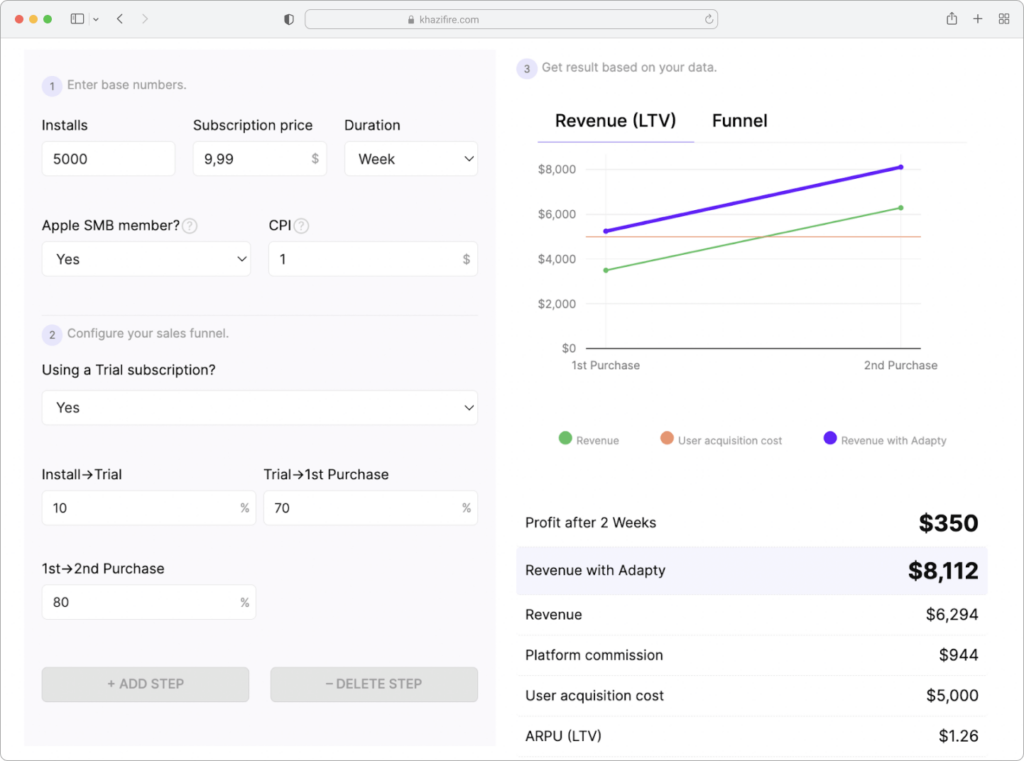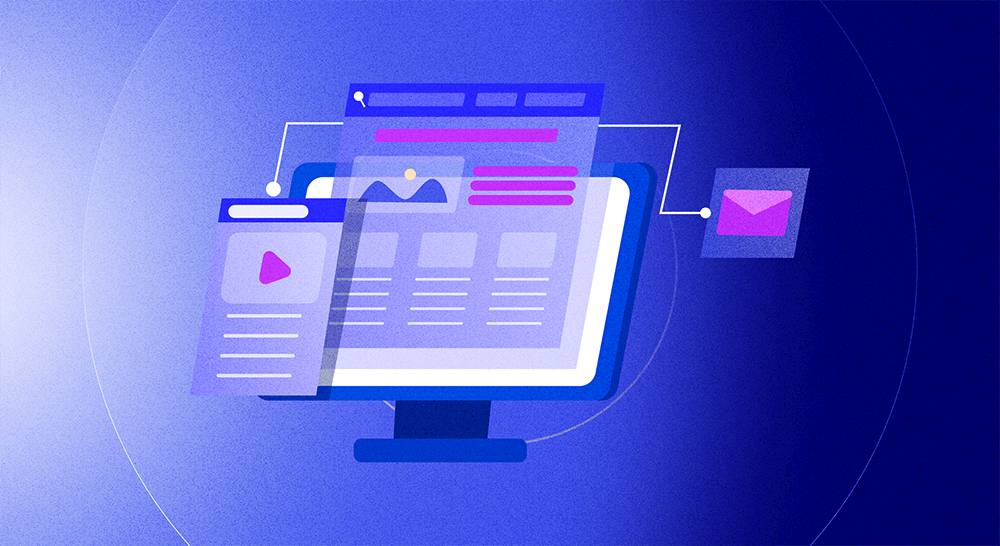How to choose a publisher for a subscription app?

Updated: February 21, 2024
23 min read

Introduction
The subscription app market has experienced significant growth in recent years. It offers developers lucrative opportunities for monetization. One crucial decision that can make or break the success of a subscription app is choosing the right publisher.
App publishers work with app developers to bring the app to market and ensure its success. The scope of their work varies from marketing and promotion to financial support.
The choice of a publisher can greatly impact your app’s visibility, reach, revenue potential, and overall success in a highly competitive app market. This article will provide guidance on how to choose a publisher for your app.
We will discuss key factors such as understanding the subscription app market, identifying your target audience, evaluating potential publishers, analyzing publisher platforms and tools, and the importance of a publisher-developer relationship. By making an informed decision when selecting a publisher, you can significantly increase the chances of your subscription app thriving in the ever-evolving app ecosystem.
Understanding the subscription app market
A subscription app is an application that requires users to pay a recurring annual or monthly fee to access premium features or content. The subscription-based business model is on the rise and the market is expanding. Health, fitness, and meditation apps are taking over the subscription app market. Gaming apps are joining the market as well.
Whichever niche you are in, it is essential to understand the dynamics of the subscription app market. The best way to do this is to analyze your app. It will help you find the right approach for the subscription revenue model to fit the needs of your users.
Adapty offers powerful subscription analytics tools to check on your app’s health. These tools provide valuable data and metrics, such as subscription retention rates, revenue trends, and user behavior. They help developers optimize their app’s performance and revenue generation strategies. Understanding the subscription app market and utilizing analytics tools help developers make informed decisions and stay ahead of the competition in the ever-evolving app landscape.

Benefits of subscription-based apps for developers and users
Subscription apps offer significant benefits for both developers and users.
For developers, the recurring revenue model provides a predictable and stable income stream. It allows for better financial planning and investment in app development. It also encourages ongoing engagement and retention. Users are incentivized to continue their subscriptions to maintain access to premium features or content. Subscription apps can foster a closer relationship between developers and users, leading to valuable feedback and ideas for app improvement.
For users, subscription apps often provide a more affordable and flexible option compared to one-time purchases. Subscribers can access premium features or content without the hassle of additional one-off payments. Users can easily cancel or change their subscriptions based on their needs. Subscription apps also offer continuous updates and improvements. It ensures users always have access to the latest features and content.

Subscription apps can benefit developers by providing a stable revenue stream and fostering user engagement while offering users affordability, flexibility, and access to updated content.
Trends in the subscription app market-2023
As of 2023, the subscription app market continues to grow with notable trends. One significant trend is the increasing adoption of subscription-based models across various app categories, including health and fitness, entertainment, productivity, and education.
- Health and fitness apps dominate the subscription app market. They offer personalized workouts, nutrition plans, and wellness resources.
- Entertainment apps include streaming services for music, video, and gaming. They remain highly popular, with users subscribing to access a vast library of licensed content.
- Productivity subscription apps offer tools for project management, note-taking, and cloud storage. They are gaining more traction among self-employed professionals and businesses. They are especially popular among those who are working from home.
- Education-based apps that offer online courses, language learning, and skill development are experiencing increased demand.
The subscription app market in 2023 is witnessing a surge in adoption across diverse categories. Users seek premium content, features, and services through subscription-based models for a seamless personalized app experience.
Identifying your target audience

Defining your target audience is one of the most important steps in developing a successful subscription app. By identifying your target audience, you can tailor your app’s features, content, and marketing strategies to meet their specific needs and preferences. It is essential both for your app design and its promotion.
Understanding your target audience allows you to create a more personalized and engaging app experience. It can lead to higher user retention and increased subscription rates.
Below we will explore methods for identifying your target users and understanding the expectations of your audience.
Methods for identifying your target users
There are several effective methods for identifying your target user:
- Market research: Conducting market research through surveys, interviews, and data analysis can help you understand the demographics, preferences, and behaviors of your potential users.
- App analytics: Utilizing app analytics tools, such as in-app analytics or user tracking, can provide insights into user behavior, engagement, and demographics.
- User feedback: Soliciting feedback from your existing or potential users can offer valuable insights into their needs, preferences, and pain points.
- Competitor analysis: Analyzing your competitors’ apps and user base can help you identify any gaps or opportunities in the market that you can capitalize on.
- Social media and user communities: Monitoring social media conversations, online forums, and user communities related to your app’s niche can provide valuable insights into the preferences, interests, and behaviors of your target audience.
These methods provide valuable insights into your target audience’s demographics, preferences, and behaviors. It will help you create a subscription app for increased user engagement and subscription rates.
How do you understand the expectations of your audience?
By understanding the preferences and expectations of your audience, you can make informed decisions on app features, content, and improvements. This results in a more satisfying and engaging user experience that encourages continued subscriptions.
Here are some tips to understand the expectations of your audience:
- User surveys: to understand what features, content, or improvements your audience expects from your app.
- User testing: Test your app with a test group to observe how users interact with your app and gather feedback on their preferences, pain points, and expectations.
- Feedback channels: Set up feedback channels within your app to encourage users to share their expectations, suggestions, and concerns.
- User personas: Create user personas based on your profiling research and data analysis to better understand your audience.
- Competitor analysis: Analyze your competitors’ apps and their user feedback to understand what your target audience expects from similar apps.
Evaluating potential publishers

You should evaluate potential publishers for your subscription app. It’s crucial to consider several criteria to make the right choice. These criteria include the publisher’s reputation and experience, marketing and promotion support, revenue models, and financial support.
Below we will look at the mentioned criteria in more detail. Careful assessment of these criteria can help you choose a publisher that aligns with your app’s goals. This approach increases the chance of a successful partnership. It ensures the best possible outcome for your subscription app venture.
Reputation and experience
The reputation and experience of a publisher are one of the most important factors to consider when selecting a partner. A publisher’s track record, success stories, and user feedback provide insights into their reliability and expertise.
A publisher with a proven track record of successful app launches and positive user feedback demonstrates their ability to deliver results. Success stories of previous apps they have published can showcase their expertise in the subscription app market.
You should look at user feedback. It provides valuable insights into the publisher’s performance in terms of app quality, customer support, and overall user satisfaction. Considering these factors can help you choose a publisher with a solid reputation and extensive experience.
Marketing and promotion support
The marketing and promotion support offered by potential publishers is an important factor to consider. A publisher that can provide effective marketing and promotion support can significantly impact the success of your app on the market. It can include assistance with app store optimization (ASO), social media marketing, email campaigns, influencer partnerships, and other promotional activities.
Check what this mobile app publisher did for other clients. Ask the potential publisher to send you their portfolio and offers catered to your application.
Assessing the level of marketing and promotion support offered by mobile publishers can help you determine their commitment to driving user acquisition and retention. It should aim for maximizing your app’s visibility and revenue potential.
Revenue models and financial support

Pay attention to the revenue models and financial support offered by publishers. Mobile app publishers may use various revenue models, including subscriptions, in-app purchases, advertising, or hybrid models. Understanding the publisher application revenue models is one part of it. Knowing how they align with your app’s goals and pricing strategy is crucial for long-term success. You can learn more about subscription models in the Guide on how to get paid subscribers for your app.
Evaluate the mobile app publisher’s financial support options. See if they offer funding, resources, and investment in marketing efforts. It directly impacts your app’s growth potential. Revenue-sharing conditions, such as the percentage of revenue retained by the publisher, should also be assessed and compared.
These factors can help you choose a mobile publisher offering the right revenue models and financial support. It ensures a mutually beneficial partnership for your subscription app venture.
10 ideas
to increase
paywall conversion
Get an ebook with insights
and advice from top experts
Analyzing publisher platforms and tools
Publishers often offer their own platforms and tools that can aid in the development, distribution, and management of your app. These platforms and tools can include user analytics and insights, app monetization strategies, customer support, and user retention. Evaluating the quality, functionality, and user-friendliness of these platforms and tools can provide insights into the level of support and resources a publisher can offer to optimize your app’s performance.
The quality and effectiveness of the publisher’s platforms and tools can significantly impact your app’s success. They can streamline app development, enable effective app store management, and provide valuable insights through analytics and reporting. Additionally, publisher-provided platforms and tools can facilitate communication and collaboration between you and the mobile app publisher, ensuring a smooth partnership.
Below we will provide details on publisher app platforms and tools. You will see how they align with your app’s requirements and support your app’s growth and performance goals.
User analytics and insights
App developers can gain valuable insights into user behavior, preferences, and engagement patterns from data analysis. It allows for data-driven decision-making and app optimization. It is crucial to evaluate the publisher’s user analytics tools when selecting a partner for your app.
The publisher’s analytical tools and support can determine the level of visibility and understanding you have of your app’s performance. Robust and user-friendly analytics tools can provide in-depth insights into key metrics, such as user acquisition, user retention, subscription conversion, and revenue generation.
It is essential to consider the quality and comprehensiveness of analytical tools and the level of support in data analysis and insights.
App monetization strategies
A publisher can offer various monetization tools and strategies to optimize your app’s revenue potential. You can project your current and future revenue from subscriptions with the in-app subscriptions calculator by Adapty.

The publisher’s monetization tools can include features such as in-app purchases, subscription management, ad integration, and pricing optimization. There are many ways to apply these to your app and find the right solutions. A mobile app publisher should be able to advise you on that. But it is a good idea to research this beforehand and evaluate the options. You can learn ways to monetize your app here.
If you are looking for bulletproof ideas for monetization, try this guide on how to boost mobile app subscriptions with holiday marketing.
A mobile publisher’s tools can help you effectively monetize your app. They may offer flexible pricing plans, targeted promotions, and seamless payment options for users. Publishers with expertise in app monetization can provide valuable insights. It includes the best industry practices, pricing models, and revenue optimization strategies.
First, consider the publisher’s track record in successful monetization. Second, the variety and effectiveness of their monetization tools. Third, the ability to provide customized solutions for your app’s specific needs. Choosing a publisher with efficient monetization tools and strategies can help you optimize your app’s revenue potential.
Customer support and user retention
The publisher’s tools and strategies for customer support and user retention can impact user satisfaction and long-term retention. Efficient customer support tools may include in-app messaging, chat support, a knowledge base, and a support ticketing system for prompt issue resolution. The publisher also may offer user retention strategies such as personalized engagement campaigns, loyalty programs, and regular app updates to keep users engaged and subscribed.
When evaluating potential mobile app publishers, carefully assess customer support and user retention tools and strategies they provide. Consider factors such as responsiveness, effectiveness, and a proven track record in user retention and engagement. Partnering with a publisher that excels in these areas can help you build a loyal user base, reduce churn, and drive sustained success for your subscription app.
By collaborating with a publisher that prioritizes customer support and user retention, you can enhance user satisfaction, optimize app revenue, and achieve sustained growth in the competitive subscription app market.
The importance of the publisher-developer relationship
A strong partnership between the publisher and developer is built on trust, communication, and collaboration. It is the underlying factor of the app’s growth and success.
Start with clear objectives and goals of your teams. You should have specific targets discussed and signed off by both parties. Establish clear expectations and responsibilities from the outset. The mobile app publisher should commit to delivering the results you want. And you should commit to assisting the publisher. A well-defined contract that outlines the roles, responsibilities, and expectations of parties can serve as a guiding document.
Regular communication enables both parties to work together towards common objectives and make informed decisions that benefit the app’s performance. Regular check-ins, progress reviews, and performance evaluations can keep the partnership on track.
Constructive feedback from both sides is important. It allows for identifying areas of improvement, addressing problems, and optimizing the app for better user experience and engagement. A publisher should provide timely feedback and guidance. A developer should be receptive to feedback and actively work on improvements.
Be aware of potential red flags and deal-breakers in the publisher-developer relationship. Red flags may include a lack of transparency, poor communication, delayed payments, or failure to fulfill contractual obligations. Deal-breakers may include conflicts of interest, unethical business practices, or a misalignment of values and vision for the app. If you notice any of these, discuss them with the publisher and try to clarify. If this doesn’t work, learn from your mistakes and start building a new relationship with another publisher.
Partnerships require trust, communication, collaboration, and shared goals. You should maintain open communication and address issues proactively.
A thriving publisher-developer relationship can lead to long-term success. It’s important to notice potential red flags and deal-breakers that may impact the partnership. Take appropriate early steps to prevent and mitigate any issues that may arise.
Case studies: successful subscription app publisher partnerships
You can learn from examples of successful subscription app publisher partnerships.
In 2022, a fasting app called Prime Fasting generated its first $1M in revenue with the help of its publisher – Union Apps. They used Adapty for in-app subscriptions, analytics, and paywall A/B testing. Union Apps helped with product development, marketing, financial reporting, and revenue generation. This successful partnership exemplifies how Union Apps and Adapty can help app publishers optimize their subscription strategies and achieve significant revenue milestones.
Another example of Union Apps publisher’s successful partnership is with the app OctaZone. A specific Adapty test suggested by the publisher led to increased Lifetime Value (LTV) and improved monetization. Lessons learned from this partnership include performance tracking and continuous optimization of the app and subscription offers based on analytics, user feedback, and market trends.

Another successful subscription app publisher partnership is the collaboration between Apple Arcade, a gaming subscription service and game publisher, and ustwo games, an indie game development studio. There are two factors behind their success. First, ustwo games’ reputation for creating innovative and visually appealing games. Second, Apple Arcade’s curated platform provides exposure to a large and engaged user base. The partnership allowed ustwo games to access a new revenue stream through subscription revenue sharing. And Apple Arcade gained access to high-quality, exclusive games for their subscribers.
Lessons learned from this partnership include the importance of aligning creative vision and game quality, leveraging platform reach, and providing ongoing updates and new content to keep subscribers engaged. The best practices are open communication, regular performance evaluations, and mutual support in marketing and promotion efforts.
Conclusion
Finding the right publisher for your subscription app can greatly impact its success in the competitive app market. In this article, we discussed factors to consider when evaluating potential publishers. It includes reputation and experience, marketing and promotion support, revenue models, and financial support. We also highlighted the importance of building a strong publisher-developer relationship, based on effective communication, mutual trust, and shared goals.
Remember to prioritize factors such as reputation, experience, marketing support, revenue models, analytics tools, and customer support strategies when selecting a publisher for your subscription app. If a mobile app publisher works with analytics tools with a proven track record like Adapty it increases your chances to succeed in the subscription app market.
The right publisher will bring expertise, support, and resources to boost your app’s growth, engagement, and revenue. It’s essential to carefully evaluate each potential partner and conduct thorough research to ensure they align with your app’s goals and requirements.
Make an informed decision to increase your app’s chances of success and achieve your monetization goals. Choose a publisher that aligns with your app’s vision and requirements, and leverage their expertise to maximize your app’s potential in the competitive app market.
FAQs
Recommended posts

Trends-insights
32 min read
July 24, 2023






